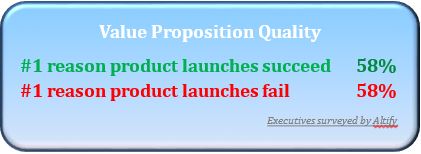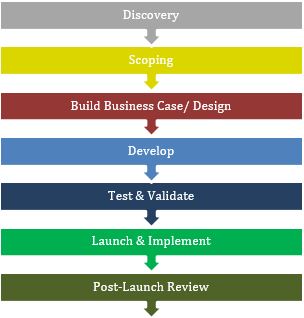According to Scott J. Edgett of Stage-Gate® International, over 80% of North American companies use some form of a Stage-Gate innovation model. R.G. Cooper estimates a higher percentage in Europe. Given the huge outlays on R & D in B2B markets, clearly defined processes for development of new products are essential to maximize the speed, efficiency, and productivity of R & D activities.
 Customer driven focus tops the list of Edgett’s five proven success ingredients for a good Stage-Gate process. As he puts it, “Customer focused innovation drives success rates that are twice as high in the marketplace and have a much higher productivity rate (4.5 times). It is the number one key to success and profitability.” Edgett says that “the goal is to maintain a sharp focus on developing and delivering new products that are differentiated, solve major customer problems and offer compelling value propositions to the customer.”
Customer driven focus tops the list of Edgett’s five proven success ingredients for a good Stage-Gate process. As he puts it, “Customer focused innovation drives success rates that are twice as high in the marketplace and have a much higher productivity rate (4.5 times). It is the number one key to success and profitability.” Edgett says that “the goal is to maintain a sharp focus on developing and delivering new products that are differentiated, solve major customer problems and offer compelling value propositions to the customer.”
In a recent blog, Mike Chase emphasizes the difference between a Markets Requirement Document (MRD) and a Product Development Plan (PDP) for capital equipment in development. The MRD focuses on the business case, asking questions about the market opportunity and whether the product can win. Without a good MRD, “you could end up building the product right, but not necessarily the right product.”
Customer Value and Innovation. Stephan Liozu makes the explicit connection between effective innovation and value pricing. He stresses the need for a Value Proposition and a quantitative understanding of value early in the innovation process as critical to capturing the value of a new product in its price. His advice is clear. “If you have a game-changing innovation and are struggling to estimate differential value, do not improvise or do not simply give up. It is a good problem to have!” As he puts it, “the reward of getting it done right is priceless.”
Good organizations assure that their Stage-Gate process focuses on B2B customers by requiring deliverables at specific gates based on the value that their product delivers. The best organizations start their customer value milestones early and require follow-on validation and refinement, so that their teams improve their understanding of value throughout the development process. In this blog, we draw on our experience with LeveragePoint customers who do this well. Based on their approaches, we hope to summarize some best practices for customer value deliverables at specific gates in a productive Stage-Gate process.
But before analyzing a good Stage-Gate process from the beginning, let’s get some perspective on outcomes and endpoints by working backwards from the product launch.
 Deliverables Needed for Product Launch: Working Backwards. A fundamental aim of any product launch team should be to have a powerful Value Proposition sales-ready at launch. In a survey by Altify, executives identified Value Proposition quality as the number one reason for product launch successes and for product launch failures. Building Value Propositions supports better product launch decisions, including price setting and offer design. Strong Value Propositions support sales confidence and are an efficient way for marketing and sales teams to understand and communicate what a new product delivers for the customer.
Deliverables Needed for Product Launch: Working Backwards. A fundamental aim of any product launch team should be to have a powerful Value Proposition sales-ready at launch. In a survey by Altify, executives identified Value Proposition quality as the number one reason for product launch successes and for product launch failures. Building Value Propositions supports better product launch decisions, including price setting and offer design. Strong Value Propositions support sales confidence and are an efficient way for marketing and sales teams to understand and communicate what a new product delivers for the customer.
- Sales-Ready Value Proposition at Launch. A Value Proposition, developed and tested prior to launch, serves as a critical piece of content to train sales teams and support them in their early customer discussions. The Value Proposition helps sales teams understand the business outcomes a customer can expect by buying the product, a critical component of training. It provides content for customer conversations, helping sales to qualify accounts and move qualified prospects through a buying process. In order to have a Value Proposition sales-ready at launch, a commercial team needs to start understanding value earlier in development. The team needs an initial, presentable version of the Value Proposition that can be tested by sales mobilizers and refined by product managers at least one to two months before the launch date.
- Value Based Pricing, Segmentation and Offer Design. From a strategic pricing perspective, quantifying the customer’s Value Proposition early is helpful. The sooner value hypotheses are formulated, the sooner they can be tested in customer interviews, product performance studies, and market research. The process of understanding and refining value hypotheses not only helps establish a central value-based price for the product, but often identifies value-based differences between accounts that form the basis for effective segmentation and for the design of better offerings (good-better-best) to fit those segments. Quantifying and dollarizing value early provides customer insights that improve the go-to-market strategy for the product.
The benefits of value modeling, value pricing, and value selling are clear enough. The evidence shows that implementing a value based-pricing strategy improves EBITDA by an average of 8%[1] and that the ROI of investing in value based strategies ranges from 130% to 900%.[2] Product teams who incorporate value into their discussions say that it helps them understand their positioning better and that it makes their decision-making customer-centric. CRM data from B2B organizations adopting value selling show that opportunities where a Value Proposition is used have 5-15% higher win rates and 5-25% higher price outcomes.
 Deliverables of the Development Process: Working Forward through Stage-Gates. The added benefit of understanding value through a Stage-Gate development process is to make better product development decisions early, including killing and modifying projects. Taking launch-related endpoints into consideration, let’s look at value deliverables step by step through a Stage-Gate (or phase-gate) process. At the end of each stage, a project passes through a gate where a decision is made whether or not to move the project forward to the next stage. Gate reviews, involving members of senior management, serve as quality-control checkpoints to evaluate the business case for the program and approve the project’s plan and resources, with a specific focus on the next stage of the process.
Deliverables of the Development Process: Working Forward through Stage-Gates. The added benefit of understanding value through a Stage-Gate development process is to make better product development decisions early, including killing and modifying projects. Taking launch-related endpoints into consideration, let’s look at value deliverables step by step through a Stage-Gate (or phase-gate) process. At the end of each stage, a project passes through a gate where a decision is made whether or not to move the project forward to the next stage. Gate reviews, involving members of senior management, serve as quality-control checkpoints to evaluate the business case for the program and approve the project’s plan and resources, with a specific focus on the next stage of the process.
While different organizations formulate their gates differently, a typical process can be seen in the diagram to the right. Let’s take each stage in turn, and identify the customer value deliverables for that stage that will drive successful customer-focused development.
 In the Discovery stage, the primary aim is to identify potential opportunities based on brainstorming, conversations and light desk research. Opportunities invariably involve a specific market where our team identifies an unmet customer need or a gap among current offerings. We consider the possibility of a new product or a new application of an existing product to meet the need or fill the gap.
In the Discovery stage, the primary aim is to identify potential opportunities based on brainstorming, conversations and light desk research. Opportunities invariably involve a specific market where our team identifies an unmet customer need or a gap among current offerings. We consider the possibility of a new product or a new application of an existing product to meet the need or fill the gap.
- Discovery Stage Value Deliverable: Show v1 of a Value Map of the market. A Value Map displays prices and value for competing products in a marketplace, usually with prices on the y-axis and a weighted value score based on product features/ performance/ benefits on the x-axis. At this stage, having a sense of competing alternatives, their prices, and preliminary value scores provides initial perspective on positioning for our proposed innovation.
 Scoping involves preliminary investigation based primarily on desk research and team discussions to evaluate the product and the market. Is our product feasible? Is our product likely to be differentiated in a meaningful way? Accounting for competitive threats and understanding product strengths and weaknesses are essential. This stage seeks to kill projects unlikely to succeed before significant time is spent on their design.
Scoping involves preliminary investigation based primarily on desk research and team discussions to evaluate the product and the market. Is our product feasible? Is our product likely to be differentiated in a meaningful way? Accounting for competitive threats and understanding product strengths and weaknesses are essential. This stage seeks to kill projects unlikely to succeed before significant time is spent on their design.
- Scoping Stage Value Deliverable: Defend v2 of the Value Map. Using available data to refine our understanding of competing alternatives, their prices, and their market share provides perspective on the competitive landscape. Building team consensus on customer benefits and their relative importance (the basis for the weights in a value score) drives the discussion in a customer-centric direction. Scoring alternatives on each of these benefits highlights differentiation of our proposed product relative to competitors.
 The Build Business Case/ Design stage is more labor intensive, involving primary customer, market, and technical research. The objective in this stage is to build a Business Case that includes product and project definition, project justification, and a proposed plan for development. Our product benefits need to be tested and understood more deeply based on customer interviews in order to make a better assessment of our likelihood of success. Before spending serious money and time on development, both plans and success criteria are essential.
The Build Business Case/ Design stage is more labor intensive, involving primary customer, market, and technical research. The objective in this stage is to build a Business Case that includes product and project definition, project justification, and a proposed plan for development. Our product benefits need to be tested and understood more deeply based on customer interviews in order to make a better assessment of our likelihood of success. Before spending serious money and time on development, both plans and success criteria are essential.
- Build Business Case/ Design Stage Value Deliverable: Explain v1 of a Value Model plus identify potential segments. A Value Model goes beyond a Value Map to understand (a) how our product delivers differentiated value and (b) how much value (in dollars or euros) it delivers relative to one competitor (preferably the next best alternative). At this stage, value driver estimates may be preliminary and value may be understood relative to one alternative and for one segment. Having well-formed value hypotheses for our product provides initial thinking about a value based price and helps to set the agenda for the development program. Failure to confirm value hypotheses in the next stage can be a good reason to kill a project or to put it on hold. Identifying potential segments at this stage helps to define where to test value in the next stage. Identifying segments also helps to target alpha candidates if an alpha is to be involved in the Development stage.
 The Development stage includes detailed design of our product, including a prototype, as well as the design of the operations or process required for full scale production. In parallel, commercial plans should move forward with more in-depth customer discussions of our product and how it impacts their business. In the process, the team creates a timeline with specific milestones to be achieved. A good development process should involve multifunctional members of the team and should be subject to frequent plan revision based on learnings.
The Development stage includes detailed design of our product, including a prototype, as well as the design of the operations or process required for full scale production. In parallel, commercial plans should move forward with more in-depth customer discussions of our product and how it impacts their business. In the process, the team creates a timeline with specific milestones to be achieved. A good development process should involve multifunctional members of the team and should be subject to frequent plan revision based on learnings.
- Development Value Deliverable: Present v2 of the Value Model/ Value Proposition with segmentation embedded. During a stage that is frequently technology-centric, explicit value deliverables to improve the Value Model should be a primary objective that keeps this stage customer-focused. These improvements should include: (a) validation and refinement of initial value estimates in v1 of the Value Model, (b) extension of the Value model to other segments and other relevant alternatives (c) converting the improved Value Model into a presentable Value Proposition.
An alpha customer provides direct access that enables our commercial team to challenge and improve initial value estimates. Interviews and conversations with other potential customers is a means to refine our thinking on segmentation, including a better understanding of more than one competitive reference point. With a better understanding of segments, our commercial team can begin to think about offering strategies (good-better-best and other approaches) as we head into testing and validation. Presenting value clearly at the gate review, as if explaining differentiated value to customers, drives our team toward good habits in communicating value simply and clearly at launch. Converting a Value Model into a presentable Value Proposition by this stage, if not earlier, is an important discipline that keeps the customer at the center of internal discussions.
- Development Value Deliverable: Present v2 of the Value Model/ Value Proposition with segmentation embedded. During a stage that is frequently technology-centric, explicit value deliverables to improve the Value Model should be a primary objective that keeps this stage customer-focused. These improvements should include: (a) validation and refinement of initial value estimates in v1 of the Value Model, (b) extension of the Value model to other segments and other relevant alternatives (c) converting the improved Value Model into a presentable Value Proposition.
 The Testing and Validation stage includes product testing, manufacturing and services testing and market testing in the run-up to product launch. This includes scale up and QA tests, further trials in the lab and further testing of the product in practice, potentially with beta customers. Wider market research, either as needed or as part of a systematic discipline, is often deployed here, to help set prices and to make decisions about offer design. This is the last chance for our commercial team to refine our approach based on research, rather than on trial and error in the marketplace.
The Testing and Validation stage includes product testing, manufacturing and services testing and market testing in the run-up to product launch. This includes scale up and QA tests, further trials in the lab and further testing of the product in practice, potentially with beta customers. Wider market research, either as needed or as part of a systematic discipline, is often deployed here, to help set prices and to make decisions about offer design. This is the last chance for our commercial team to refine our approach based on research, rather than on trial and error in the marketplace.
- Testing and Validation Value Deliverable: Present and test v3 of the Value Proposition including customized content for segments and for alternative offerings. Adapt Value Proposition to specific local markets. This version of the Value Proposition should include learnings and refinement from beta customers, product testing in practice and market research. Good testing provides the opportunity to base product claims, that will be useful in launch, on actual customer experience and case studies. v3 of the Value Proposition should get serious attention at the gate review, especially in the approval of pricing and offer strategy. For global product launches, this is the stage where general product materials are approved so that they can be adapted to local circumstances. This should include the Value Proposition and adapting local pricing strategy to address local conditions. Although gate review is crucial, this stage is also a phase where the commercial team is building our tactical launch plan, including the work we do with sales teams. Identifying sales sponsors and sales mobilizers is important to test use of the Value Proposition by customer-facing members of the team who will actually use it.
 Launch and Implementation. The gated development process often starts to blur in the immediate runup to launch, but most organizations have a formal or informal product launch checklist. This includes initial advertising, publicity and interviews. It involves finalization of projections, implementation processes, and pricing. Sales training and release of sales content is usually critical in launch preparation.
Launch and Implementation. The gated development process often starts to blur in the immediate runup to launch, but most organizations have a formal or informal product launch checklist. This includes initial advertising, publicity and interviews. It involves finalization of projections, implementation processes, and pricing. Sales training and release of sales content is usually critical in launch preparation.
- Launch and Implementation Value Deliverable: Identify and track 10 early opportunities for the use of the Value Proposition. A strong Value Proposition is core content for sales education as well as for the product launch. Getting early feedback from sales mobilizers and selected members of the sales team provides immediate data on what is working in the product launch and what needs to be fixed. Immediate feedback from value sellers in the organization helps to identify early success stories in the product launch as well as best practices for dealing with customer challenges in practice. Publicizing success and taking agile steps to improve launch content further, based on a disciplined approach to gathering feedback, help to generate momentum in product uptake and sales.
 While formal gate review processes may not extend to Post- Launch Review, a continuously agile approach to sales and marketing is the new norm. Sales managers, under pressure to meet targets are sure to focus on continuous improvement of content and sales team practices. They will undoubtedly want to replicate what is working.
While formal gate review processes may not extend to Post- Launch Review, a continuously agile approach to sales and marketing is the new norm. Sales managers, under pressure to meet targets are sure to focus on continuous improvement of content and sales team practices. They will undoubtedly want to replicate what is working.
- Post-Launch Review Value Deliverable: Drive sustainable use of the Value Proposition in the sales process. Success generates momentum in adopting practices that work, but only if that success is publicized and only if new users are well supported. Value Propositions at the point of initial sale are useful in setting expectations for implementation and for routine business reviews with customers. Successful use of Value Propositions in product launch process and in implementation needs to be sustained with content, with skills training and with strong coaching.
 Value Based Decision-Making, Pricing and Selling. All great B2B organizations are customer-centric. Innovative businesses benefit by making their product and pricing decisions based on customer value. They only get the full benefit of that customer understanding if they put Value Selling into practice. Value conversations bring the customer’s business problems into focus, highlighting our differentiation in terms of the outcomes we deliver. This helps improve the quality of gated development decisions, killing bad projects earlier. It also helps improve the success of the products that make it through the gates by driving faster sales momentum at launch.
Value Based Decision-Making, Pricing and Selling. All great B2B organizations are customer-centric. Innovative businesses benefit by making their product and pricing decisions based on customer value. They only get the full benefit of that customer understanding if they put Value Selling into practice. Value conversations bring the customer’s business problems into focus, highlighting our differentiation in terms of the outcomes we deliver. This helps improve the quality of gated development decisions, killing bad projects earlier. It also helps improve the success of the products that make it through the gates by driving faster sales momentum at launch.
To learn more about how to quantify value see:
Can Your Sales Team Sell Your Solution’s Value?
To learn more about how sales teams use Value Propositions see:
Value Propositions for B2B Sales Effectiveness
[1] See John Hogan, “Building a World-Class Pricing Capability: Where Does Your Company Stack Up?” Monitor Group Perspectives, 2008.
[2] See Stephan Liozu and Andreas Hinterhuber, eds., The RoI of Pricing, Measuring the Impact and Making the Business Case (Routledge, 2014), especially the chapter by Stephan Liozu, “RoI and the impact of pricing: the state of the profession.”

